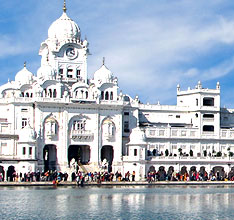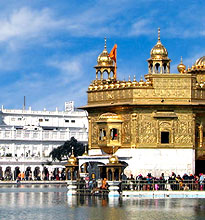 Amritsar is famous as the pilgrimage center in Amritsar, with numerous holy places in and around. The city owes its name to the holy lake inside the Harmandar Sahib (Amrit meaning nectar, Sar meaning lake). Popularly, it is believed that the city was laid in 1574 and thus it is one of the most ancient and fascinating cities of India. Amritsar is mainly known for the Golden Temple, which attracts million of people from across the globe every year. However, there are many other tourist attractions in the city, like Jalianwala Bagh, Durgiana Mandir, Baba Atal Rai Tower, and Wagah Border, worth exploring. These tourist places have been discussed below.
Amritsar is famous as the pilgrimage center in Amritsar, with numerous holy places in and around. The city owes its name to the holy lake inside the Harmandar Sahib (Amrit meaning nectar, Sar meaning lake). Popularly, it is believed that the city was laid in 1574 and thus it is one of the most ancient and fascinating cities of India. Amritsar is mainly known for the Golden Temple, which attracts million of people from across the globe every year. However, there are many other tourist attractions in the city, like Jalianwala Bagh, Durgiana Mandir, Baba Atal Rai Tower, and Wagah Border, worth exploring. These tourist places have been discussed below.Places to See In Amritsar
Golden Temple
Golden Temple is known world-wide and people visit the Temple with extreme devotion. The Temple also called Sri Harmandir Sahib was laid by Sri Guru Das in the 14th century. The Temple reflects the fantastic amalgamation of Hindu and Muslim style of architecture. It flaunts a huge dome made out of pure gold. It is surrounded by a large Sarovar (manmade lake), known as the Amrit Sar (Lake of Holy Water or Immoral Nectar). There are four entrances to the Temple on all the four sides, signifying the importance of acceptance and openness. There is arrangement for Bundara (lunch/dinner) throughout the year for the visitors.
Jallianwala Bagh
Jallianwala Bagh is historical for the murky day of 13 April 1919, when the innocent Indians were brutally killed in a mass. The Jallianwala Bagh Martyr's Memorial is built in memory of the innocent lives sacrificed in the deadly massacre with no good cause. It is situated in close affinity of the Golden Temple.
Sri Akhal Takht Sahib
Sri Akal Takht Sahib is a famous pilgrimage place for the Sikhs in Amritsar. It is the central altar for Sikh political assembly. Akal Takht literally means the Eternal Throne and the place forms a part of the Golden Temple complex. It is situated on the other end of the causeway, connected to the Harmandir Sahib and faces the Darshani Deohri.
Gurdwara Baba Atal Sahib
Gurdwara Baba Atal Sahib is one of the important tourist spots of Amritsar. Built in 1778-1784, it encompasses the rich beauty of culture and tradition of Punjab. The tallest building in Amritsar, the gurdwara is octagonal in shape, with a height of about forty meters.
Shri Durgiana Temple
Shri Durgiana Temple is one of main pilgrim places in Amritsar. The temple, also called Shree Durgiana Tirath or Sitla Mandir, is situated outside the Lohgarh Gate in Amritsar. It is situated a few yards away from the Amritsar railway station and about 1.5 km from the Bus Stand.
Ram Bagh
Ram Bagh Garden attracts a lot of tourists every year, owing to the enormous natural beauty it encompasses. It used to be the summer palace of Maharaja Ranjit Singh (1780-1839) in the past. Earlier, it was called the Company Garden. Later, Maharaja Ranjit Singh changed the name to Ram Bagh, to commemorate his unflinching devotion to Guru Ram Das.
Ram Tirath Temple
The temple is located on the Amritsar-Chogawan Road. It is the place where Valmiki Maharaj is supposed to have composed Ramayana.
Mata Mandir Temple
Mata Mandir Temple, situated at Rani ka Bagh, was developed by a grand old lady. This temple is built on the lines of the holy shrine of Mata Vaishno Devi at Katra (Jammu).
Gurudwaras
Like any other place in Punjab, Amritsar has a number of gurdwaras.
Gurdwara Ramsar Sahib
It is one of the historical shrines situated on the banks of Ramsar Sarovar, near Chativind Gate, on north-east of the Golden Temple. It is at this place that Guru Arjan Dev, the fifth Sikh Guru, spent over a year to compile the holy Guru Granth Sahib.
Gurdwara Guru Ke Mahal
This gurdwara used to be the residential house of Shri Guru Ramdas (founder of Amritsar). The birth anniversary of Guru Tegh Bahadur is the main festival celebrated here.
Gurdwara Chheharta Sahib
This gurdwara is located near the village of Guru Ki Vadali, at a distance of 7 km from Amritsar. The village is the birthplace of the Sixth guru, Hargobind Sahib, son of Guru Arjan Dev.
Gurdwara Pippli Sahib
This gurdwara is built in the memory of the fifth Sikh Guru, Guru Arjan Sahib. It derives its name from the peepal tree which once stood here.












